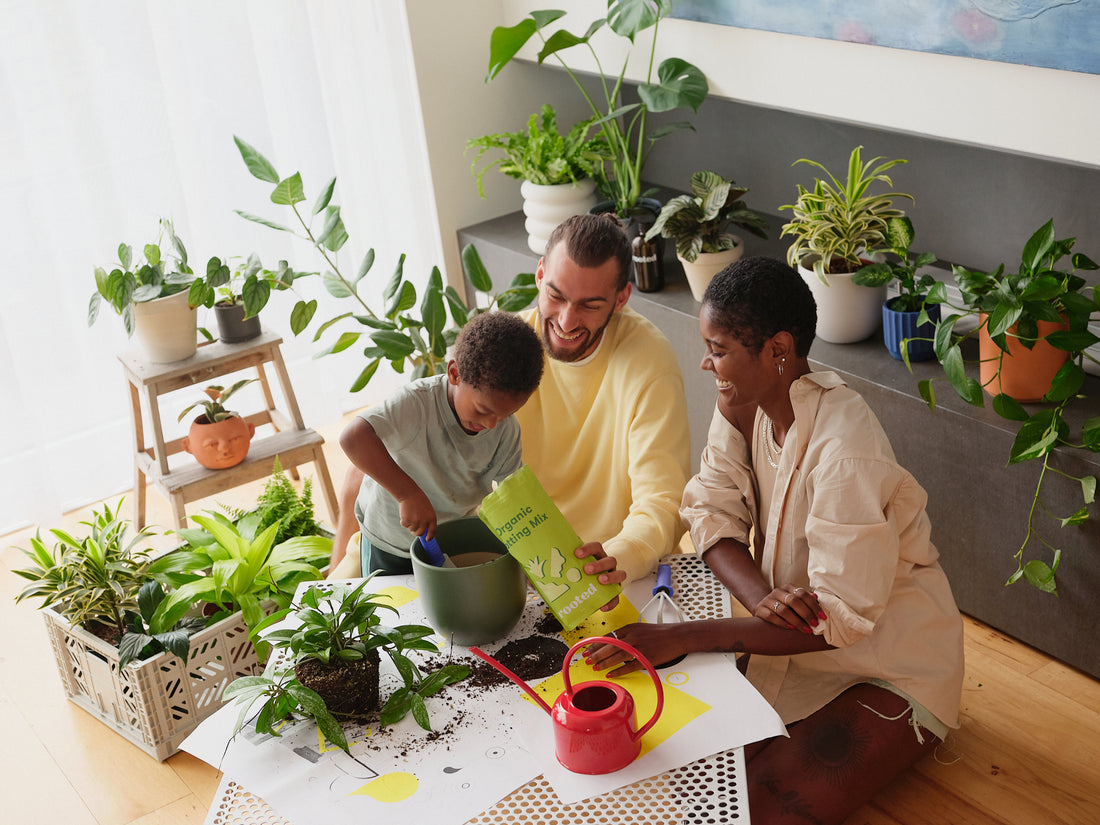Growing Your Own Herb Garden

It's time to spice up your plant game. Growing a personal herb garden is not only fun, but incredibly rewarding and way more sustainable than store-bought items. By maintaining an herb garden at home, you're cutting back on single-use plastics and trips to the store, which ultimately saves you time and money - all while ensuring a cleaner planet! 🌎🌱
It's easier than you think, and we're here to set you up for success. Want to start from seed? Check out our guide here.
General Care
Most herbs require the same general care. Follow our guide, and you'll be hosting BBQ's that fill your mates with envy within weeks.
![]() Bright light. 6-8 hours of direct sun is preferred.
Bright light. 6-8 hours of direct sun is preferred.
![]() Water thoroughly when the soil is dry 2" down. Never allow soil to dry out.
Water thoroughly when the soil is dry 2" down. Never allow soil to dry out.
![]() Our herbs are pet-friendly with the exception of oregano, mint, and parsley.
Our herbs are pet-friendly with the exception of oregano, mint, and parsley.
![]() Allow it to reach 6-12" before harvesting. Pinch off 1/3 of the plant.
Allow it to reach 6-12" before harvesting. Pinch off 1/3 of the plant.
![]() Craft, admire, and enjoy.
Craft, admire, and enjoy.
Outdoor versus Indoor
So, where do you start? One of the most common questions surrounding herb gardens is where to plant them. It's true that herbs do best outside when they're planted straight into the ground, but you can also grow a very happy garden in containers, and even indoors. Here you'll find best practices for your method of choice.
In-Ground Garden
Directly plant your herbs into the ground or into a gardening bed by following these steps:
- Dig a hole twice as wide and the same depth as the nursery pot. Take the herb out of its nursery pot. Loosen any tightly bound roots, then place the root ball into the ground and cover it with soil (not too deep)!
- Thoroughly water the root zone after planting.
- Consider adding mulch to avoid weed growth and to insulate soil.
Outdoor Container Garden
Plant your herbs in containers in an outdoor setting by following these steps:
- Double your pot size - herbs grow quickly, so you want to make sure they have plenty of space
- Ensure proper drainage. You'll likely be watering them every few days, and the last thing you want is for the roots to sit in a pool of water.
- Thoroughly saturate the soil after planting, and check every few days.
Know your zone! When planting anything outdoors, it's important to know which hardiness zone you live in. A Hardiness Zone Map shows you which plants are most likely to thrive at any given location. We know - sounds confusing. No worry, beef curry, we created this simple herb-specific map just for you.
 Indoor Garden
Indoor Garden
If you're a city dweller, chances are you don't have a backyard, or may have to share it with your neighbors. Grow your herbs indoors by following these steps:
- Place your herbs in direct light - unobstructed window sills are your best bet. If your lighting isn't top-notch, you can consider full-spectrum grow lights.
- Choose a pot with a hole. Since you'll be watering frequently, it's important to ensure that roots are never sitting in a pool of water.
- With proper upkeep, you'll have herbs growing year-round!
Wherever you decide to start your garden, a well-draining organic potting mix, rich in key nutrients, is the key to a healthy crop. You can add a compost mix to your top soil, or implement the use of an organic fertilizer to be applied every two weeks.
Harvesting
Time to eat! Herbs are ready to harvest when the plant has enough foliage to maintain growth. Always harvest before the plant flowers, as flowering can cause an unpleasant, bitter taste. Harvest frequently to maintain the shape of the plant, encourage new growth, and satisfy your tastebuds. The more you prune, the more you grow, the more you benefit. 🙌
Here are our harvesting pro-tips:
- Generally, herbs can be pruned back till 1/3 of the plant is left.
- Pinch stems and leaves with your fingers, or use a sharp, clean pair of shears or scissors to gather what's needed for the week.
- Flower power? It's not the end of the world. Pluck them off so the plant can direct its energy back into the edible foliage.
Storage
Now that you're an expert herb-grower, you're probably wondering what to do with all of your bountiful crops.
Fresh Herbs
Fresh herb cuttings can be stored in the refrigerator for about a week. We recommend wrapping them in a damp cloth to optimize freshness. Herbs can also be frozen. Just chop them up, place in an ice cube tray, fill with water, and freeze. When you're ready to use them, let the ice melt and enjoy the fresh home-grown flavors!
P.S. adding lavender ice cubes to lemonade on a hot day is *chef's kiss*. 👨🍳💋
Dry Herbs
Drying your herbs can open a realm of possibilities, from use to storage. Just cut some branches, rinse, and hang upside down to dry in bright indirect light. It takes about 2 weeks or so for them to fully dry out, but we promise it's worth the wait.
Fín
There you have it! Now stop staring at your screen and go get your hands dirty. If you have any questions, or just want to brag about your latest recipes, send us an email at hello@heyrooted.com. We're up.
